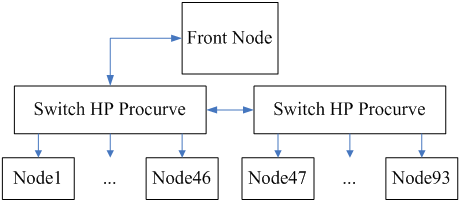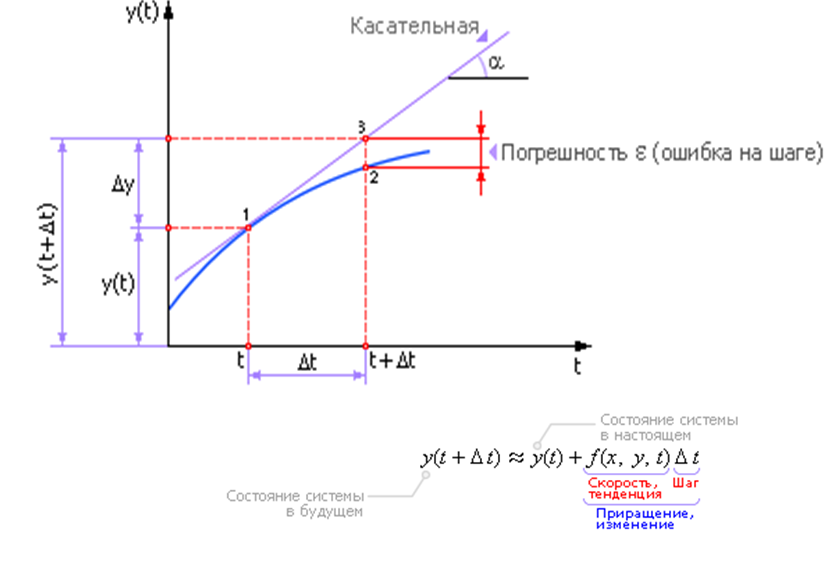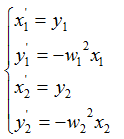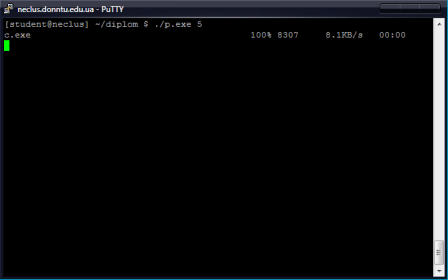Главное меню
Sereda Oleg
Faculty of computer science and technology (CST)
Department of computer engineering (CE)
Speciality: “Computer systems and networks”(CSN)
THE RESEARCH OF MODEL OF A DYNAMICAL SYSTEM ON A MULTI-PROCESSOR PLATFORM
Scientific adviser: T.D., Professor Vladimir Sviatniy
Consultant: senior teacher Aleksander Ivanov
Abstract
Сontent
Introduction
1. Theme urgency
2. Goal and tasks of the reseach
3. The research of model of a dybanical system on a multi-
Conclusion
References
Introduction
The idea of parallel processing as a powerful reserve increased performance of computing devices was proposed by Charles Babbage in about one hundred years before the advent of the first electronic computer. However, the level of technology the mid-
Development of software and hardware for research is more complex dynamic systems model provides support for object technology in the field of mechanics of solids, molecular dynamics, chemical industry, electronics, and others. In the time domain simulation systems and objects usually describes systems of differential and -
A characteristic feature of MPP multiprocessor architecture is that memory is divided and each node has access only to his memory. Like any architecture MPP has problem. The first problem is the lack of shared memory reduces the speed of the network. The second problem is that each node uses a limited amount of memory. The third problem is the complexity of the maximum resources.
Master's work is devoted to the actual scientific problem — improving the efficiency and the expansion of the class of tasks through the development of special Scheduler software and monitor system performance for multi-
2. Goal and tasks of the reseach
The aim of this study is to develop a special software scheduler and monitor implementation of the system for multi-
The main tasks of the researching:
1. An analytical model describing the analysis of dynamic systems.
2. The development of the block diagram of parallel model of a dynamic system and improving the exchange of information in this model.
3. The implementation of a multi-
4. The research of the temporal characteristics of computing and exchanges with standard programming tools.
5. Development of the scheduler and monitor multi-
The object of research: complex dynamic system for multi-
The subject of research: development of models and special scheduler software , expanding the class of tasks.
Scientific novelty consists in develop own software for parallel tasks on the cluster system.
As part of the master's work is planned to obtain relevant scientific results in the following areas:
1. Improving the efficiency of information exchange in the parallel model of a dynamic system.
2. The parallel technique of data flows with the small volumes.
3. Expanding the class of tasks on MPP-
3. The research of model of a dybanical system on a multi-
A computer cluster consists of a set of loosely connected or tightly connected computers that work together so that in many respects they can be viewed as a single system.
The components of a cluster are usually connected to each other through fast local area networks (“LAN”), with each node (computer used as a server) running its own instance of an operating system. Computer clusters emerged as a result of convergence of a number of computing trends including the availability of low cost microprocessors, high speed networks, and software for high performance distributed computing. Clusters are usually deployed to improve performance and availability over that of a single computer, while typically being much more cost-
A cluster of Donetsk National Technical University is a computer system MPP -

Figure 1 – Architecture cluster DonNTU.
On a cluster of Donetsk National Technical University used OS ScientificLinux 5.4. To transfer and synchronize exchange using UDP and broadcast, and as a means of transmission -
To create a software model to performed numerical integration of the system of differential equations obtained by reduction of the order of equations Vanderpolya [2]:

As you can see, the above system is of second order. There are some basic techniques of numerical solutions of systems of differential equations. We have chosen numerical method Euler formula trapezoids, because of the simplicity of the implementation in an iterative cycle. For us, there is not a critical error in the method. The essence of the method is outlined in Figure 2.

Figure 2 – Numerical method Euler formula trapezoids.
To create a dynamic object model uses a system of Vanderpol equations of the first order, obtained after the application of the Euler method:

The result was a system of parallel processes on the cluster. The system and the results can be seen in Figures 3 and 4.

Figure 3 – Develop parallel processes system.
Figure 4 – Results of system work.
Studies have shown performance software developed and demonstrated the possibility of simultaneous solutions of several equations. The correctness of the chosen solutions of the dynamical system can be seen on the following figures.
1. Materials from the free encyclopedia “Wikipedia” — Computer cluster [electronic resource]. – Access mode: http://en.wikipedia.org/wiki/Computer_cluster.
2. Максименко В. Л. Исследование и разработка специальных программных способов для моделирования автоколебаний. Портал магистров ДонНТУ.
3. Букатов А.А., Дацюк В.Н., Жегуло А.И. “Программирование многопроцессорных вычислительных систем”, Ростов-
4. Материалы из свободной энциклопедии “Википедия”; — Гармонический осциллятор [Электронный ресурс]. – Рeжим дoступa к ресурсу: http://ru.wikipedia.org/wiki/Гармонический_осциллятор.
5. Магистерская работа Ю.А. Иванова“Исследование и разработка алгоритмов планирования процессов реального времени моделирования сложных динамических систем”.
6. Параллельная вычислительная система – кластер NeClus[электронный ресурс]. Тип доступа: http://neclus.donntu.ru/
7. Шон Уолтон Создание сетевых приложений в среде Linux. Руководство разработчика: Москва/Санкт-
